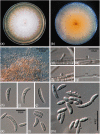Bisifusarium Delphinoides, an Emerging Opportunistic Pathogen in a Burn Patient with Diabetes Mellitus
- PMID: 31565470
- PMCID: PMC6758602
- DOI: 10.1080/12298093.2019.1628521
Bisifusarium Delphinoides, an Emerging Opportunistic Pathogen in a Burn Patient with Diabetes Mellitus
Abstract
An 82-year-old man with diabetes was admitted to the emergency department with a third-degree burn on his left leg. The deep swab specimen from his left leg was cultured on Sabouraud dextrose agar without cycloheximide and incubated at 25 °C for 5 days. On the basis of morphological characteristics and multigene phylogenetic analyses of the internal transcribed spacer region of ribosomal DNA and partial fragments of beta-tubulin and translation elongation factor 1-alpha, the causal agent of fungal skin infection was identified as Bisifusarium delphinoides, which was newly introduced by accommodating a Fusarium dimerum species complex. Thus, we describe here the first case of skin infection caused by B. delphinoides on a burn patient with diabetes mellitus based on morphological observation and molecular analysis.
Keywords: Antifungal susceptibility; FDSC; opportunistic pathogen; phylogenetic analysis.
© 2019 The Author(s). Published by Informa UK Limited, trading as Taylor & Francis Group on behalf of the Korean Society of Mycology.
Figures


Similar articles
-
Taxonomy and phylogeny of the Fusarium dimerum species group.Mycologia. 2009 Jan-Feb;101(1):44-70. doi: 10.3852/08-002. Mycologia. 2009. PMID: 19271670
-
Generic concepts in Nectriaceae.Stud Mycol. 2015 Mar;80:189-245. doi: 10.1016/j.simyco.2014.12.002. Epub 2015 Jan 29. Stud Mycol. 2015. PMID: 26955195 Free PMC article.
-
Phylogenetic Diversity and In Vitro Susceptibility Profiles of Human Pathogenic Members of the Fusarium fujikuroi Species Complex Isolated from South India.Mycopathologia. 2018 Jun;183(3):529-540. doi: 10.1007/s11046-018-0248-7. Epub 2018 Feb 14. Mycopathologia. 2018. PMID: 29445920
-
[A Case of Cutaneous Fusariosis of the Scrotum as a Complication of Acute Myeloid Leukemia].Med Mycol J. 2016;57(2):J65-70. doi: 10.3314/mmj.57.J65. Med Mycol J. 2016. PMID: 27251318 Review. Japanese.
-
Fusarium: The versatile pathogen.Indian J Med Microbiol. 2018 Jan-Mar;36(1):8-17. doi: 10.4103/ijmm.IJMM_16_24. Indian J Med Microbiol. 2018. PMID: 29735820 Review.
Cited by
-
Molecular Identification and Antifungal Susceptibility of Fusarium spp. Clinical Isolates.Mycoses. 2025 Jan;68(1):e70012. doi: 10.1111/myc.70012. Mycoses. 2025. PMID: 39800856 Free PMC article.
-
Two new species of Sordariomycetes (Chaetomiaceae and Nectriaceae) from China.MycoKeys. 2024 Mar 7;102:301-315. doi: 10.3897/mycokeys.102.114480. eCollection 2024. MycoKeys. 2024. PMID: 38495535 Free PMC article.
-
New and Interesting Fungi. 7.Fungal Syst Evol. 2024 Jun;13:441-494. doi: 10.3114/fuse.2024.13.12. Epub 2024 Jul 17. Fungal Syst Evol. 2024. PMID: 39135884 Free PMC article.
-
Taxonomic revision of Bisifusarium (Nectriaceae).Persoonia. 2025 Jun;54:197-223. doi: 10.3114/persoonia.2025.54.06. Epub 2025 May 14. Persoonia. 2025. PMID: 40746712 Free PMC article.
References
-
- Collado C, Medina L, Zorraquino A, et al. . Cutaneous fusariosis by a species of the Fusarium dimerum species complex in a patient with acute myeloblastic leukemia. Rev Iberoam Micol. 2013;30:119–121. - PubMed
-
- Nucci M, Anaissie E. Cutaneous infection by Fusarium species in healthy and immunocompromised hosts: implications for diagnosis and management. Clin Infect Dis. 2002;35:909–920. - PubMed
-
- Ricna D, Lengerova M, Palackova M, et al. . Disseminated fusariosis by Fusarium proliferatum in a patient with aplastic anaemia receiving primary posaconazole prophylaxis-case report and review of the literature. Mycoses. 2016;59:48–55. - PubMed
-
- Diepeningen AD, Al-Hatmi AMS, Brankovics B, et al. . Taxonomy and clinical spectra of Fusarium species: where do we stand in 2014? Curr Clin Micro Rpt. 2014;1:10–18.
LinkOut - more resources
Full Text Sources
